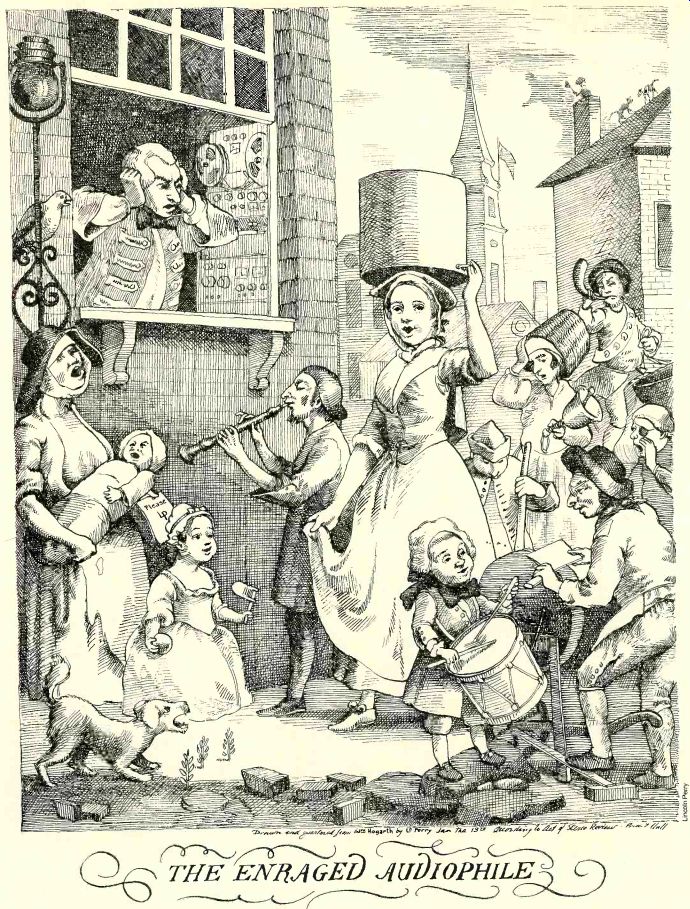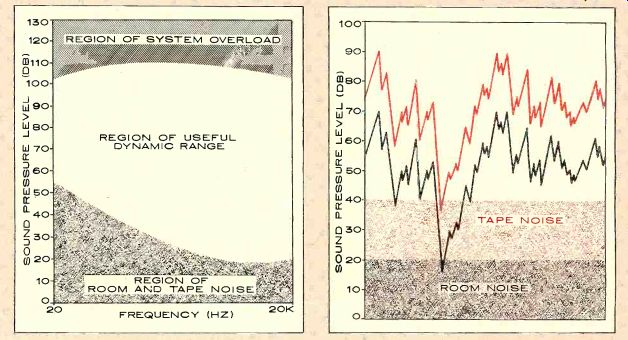
NOISE DILEMMA--Is it possible to have full dynamic range without noise?
BY DANIEL QUEEN
Factors such as playback level, listening environment, and dynamic-range compression and expansion present the recording industry with a real.
NOISE enters our private worlds from many sources, in many forms, and most of it is an un welcome intrusion on our activities. Noise appears where we work, in the communities in which we live, even in our own kitchens. In some cases it constitutes a danger to our health; in others it is merely an annoyance. Noise that turns up in our music-reproduction systems is much more than a mere annoyance, however, for it can actually limit the ability of the system to reproduce fully all aspects of a recorded musical performance.
That is why noise--or the degree of its absence--appears as a specification for most audio components. Noise reduction has become a major concern for manufacturers; it has fostered the design of special circuits and separate components, most of them devoted to lessening the noise in tape recording.
Though no one will dispute that the hum and hiss that distract us from our enjoyment of recorded music should be reduced, today there is something of a dispute concerning the extent to which this ought to be done.
A famed acoustical scientist tells a story about his experience at a school which had engaged him to correct a problem in its new library. The library had been designed with the utmost care to prevent the intrusion of outside noise. Double-glazed windows, walls with high transmission loss, the right amount of acoustic absorption, muffled ventilation ducts, and other measures had successfully brought about a very low measured noise figure in the room.
Nevertheless, the librarian complained that it was too noisy. And, in fact, it was too "noisy." Every page turning, every footfall, every door opening, every deep breath, throat clearing, or cough could be heard clearly and distinctly. For, although the sound levels of these noises were low, they were "... compression in recorded material may be necessary because of the noise in the listening environment." significantly higher than the back ground noise in the room. The cure was simple: in place of the acoustically well-designed (meaning quiet) ventilation grilles, noisier ones were installed.
The noise produced by the air rushing through them was a steady--and there fore unobtrusive--"shhh" sound that served to mask the intermittent discrete noises.
With the exception of ticks and pops on phonograph records, most of the noise that appears in a music-reproduction system is of this steady and (one might suppose) unobtrusive type. Yet such noise is objectionable in a music system. This is because the sounds that are masked are usually part of the mu sic: system noise not only obscures the low-volume passages of a musical se lection, but it can also cover up contrasting quiet notes in louder passages.
In short, audio-system noise such as hiss can be said to "distort" the musical content.
It is the nature of masking by noise that any desired signal slightly quieter than the noise will not appear to mix with the noise, but will instead simply disappear. Does this mean that a signal that is, say, at a -40-dB level will be inaudible on a tape recorder with a modest 38-dB signal-to-noise ratio?
The question has unexpected complications. Most noise measurements lump all the noise over a wide frequency range into one figure. This is known as "broadband" noise. The masking effect, however, occurs in narrow frequency bands that psycho-acousticians refer to as "critical bands" of hearing.
The exact width of these bands in hertz varies with frequency, but they are generally wider at low frequencies and narrower as frequency increases. They also vary with other characteristics of sound, whether it is "hissy," a pure tone, an impulse such as a drum-beat, or some combination of these. Nevertheless, over most of the audio range these critical bands correspond more or less with the oft-mentioned one-third-octave bands used by acoustical engineers. Thus, while the total noise of a tape player in the 20- to 20,000-Hz frequency range might be 38 dB down from a given reference level, the noise in any given one-third-octave segment (assuming that the noise is uniform with frequency) would be about 50 dB down. The music could therefore be as much as 12 dB below the rated 38-dB signal-to-noise ratio and still be heard.
Further, if the noise level varies with frequency, as it often does (some types of transistor noise increase at very low frequencies, for example), then a signal in one of the quieter noise bands might be even lower and still be audible.
Figure 1 shows that what we have been describing is the dynamic range that is, the range between the highest and the lowest sound levels the reproduction system can handle. The highest level of sound is, of course, the point of audio-system overload; the lowest is the point at which the desired sounds will begin to be masked by system noise. And, as we have seen, even a poorly rated tape recorder can provide a dynamic range in excess of 40 dB at some frequencies.
So far we have been discussing only the noise of-or in--the system. However, playback systems invariably find themselves operating in a physical environment which is itself acoustically noisy. The home listening room suffers from the noise of ventilation and air conditioning systems, traffic outdoors, appliances, etc. Therefore, while the noise level in the reproduction system determines the lowest "floor" of loud ness for the equipment, the noise in the listening room really establishes the lower level of audibility for the reproduced sound.
A typical suburban living room may have a mid-frequency noise level of around 20 dB SPL. If the output level of the tape recorder we have been using as an example is adjusted so that its noise is at approximately the same level as the room noise, the recorder would then be able to hit 70 dB SPL maximum, which is at about the level of semi-loud conversation. In contrast to this, the sound pressure level of a symphony orchestra measured at the front orchestra seats may run as high as 100 dB or so, and that of a rock band might run a steady 115 dB or more. If the playback controls are set to obtain a 90-dB loudness level in the living room, the noise of our tape-recorder example would then be pushed up to 40 dB SPL (or 20 dB above the 20-dB background room noise). This would be very noticeable, not to say obtrusive (see Figure 2). It is easy to see how the various noise-reduction systems now available for use in recording and playback are really vital if we are to come even close to achieving the full dynamic range possible in a reasonably quiet living room.
But what if all recordings were made to take advantage of this full range? In a fairly noisy environment-such as the interior of a moving automobile the softest passages of music would be completely inaudible, totally masked by road noise. If the volume control is turned up to make these quiet passages audible, then when the music gets louder the sound gets too loud and/or the system overloads. A similar situation occurs if your listening room has only a couple of thicknesses of plasterboard between it and your neighbor's. There is no way you can use the full dynamic range of your system. When you keep the volume down so the loud passages aren't heard through the walls, the soft passages are lost in the normal back ground noise. So, even though technical advances have made it unnecessary to use electronic compression (reduction of dynamic range) in the commercial recording process to squeeze the music into the narrow space between the noise and the overload point, compression in the recorded material may still be necessary because of difficulties in the listening environment.
THE recording industry, having developed the technology to solve the noise/dynamic-range problem, thus finds itself on the horns of a dilemma.
Should it produce recordings that accurately preserve the full dynamic range of the music and then let the public buy compressors if they are needed to re produce the music satisfactorily in a given environment? Or should they continue to provide compressed music with limited dynamic range, as is the current practice, leaving the audiophile to buy an expander to restore the lost dynamic range? Given those choices, which would you prefer?
Daniel Queen, a previous contributor to these pages, is president of Daniel Queen Associates, which does consulting and design work on audio and electroacoustic systems.
-------------------

Figure 1. The usable dynamic range of a music system is limited by a "floor' comprised of combined system and environ mental noise and a "ceiling" that corresponds to the clipping point of the amplifier or the overload point of the speakers.
Figure 2. If our hypothetical tape recorder is adjusted to play back with a noise level equal to the room noise, the music is too soft. Increasing the volume for the right music level makes the noise from the tape machine obtrusively loud.
Also see:
TAPE PROGRESS--The tape world looks a bit different from the manufacturer's point of view, CRAIG STARK